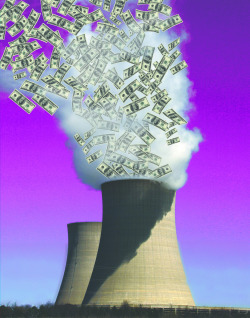"The Rust-Bucket Reactors Start to Fall"
 Harvey WassermanHarvey Wasserman, editor of Nukefree.org and author of Solartopia, has written a blog inspired by the announced closure of the Kewaunee atomic reactor in Wisconsin. He begins by stating 'The US fleet of 104 deteriorating atomic reactors is starting to fall. The much-hyped "nuclear renaissance" is now definitively headed in reverse.'
Harvey WassermanHarvey Wasserman, editor of Nukefree.org and author of Solartopia, has written a blog inspired by the announced closure of the Kewaunee atomic reactor in Wisconsin. He begins by stating 'The US fleet of 104 deteriorating atomic reactors is starting to fall. The much-hyped "nuclear renaissance" is now definitively headed in reverse.'
He points out that Kewaunee may be but the first domino to fall, describing the impact of "low gas prices, declining performance, unsolved technical problems and escalating public resistance" at numerous other old, age-degraded, troubled reactors across the U.S., including San Onofre, CA; Crystal River, FL; Cooper and Fort Calhoun in NE; Vermont Yankee; Indian Point, NY; Oyster Creek, NJ; and Davis-Besse, OH.
Harvey writes "Many old US reactors are still profitable only because their capital costs were forced down the public throat during deregulation, through other manipulations of the public treasury, and because lax regulation lets them operate cheaply while threatening the public health."
He then goes on to describe the massive repair bills (or "re-construction costs"), escalating into the hundreds of millions or even billions of dollars, looming at reactors like San Onofre and Crystal River, due to faulty replacement steam generators and a cracked containment, respectively, if their owners ever hope to restart them again.
But Harvey also points out the momentum applies to new reactors as well, such as at Vogtle, GA and Summer, SC, as well as overseas, in the wake of Fukushima, not only in Japan, but also India, and even Europe, led by Germany's nuclear power phase out.
Harvey writes about the flagship new reactors proposed in the U.S.:
"The two reactors under construction in Georgia, along with two in South Carolina, are all threatened by severe delays, massive cost overruns and faulty construction scandals, including the use of substandard rebar steel and inferior concrete, both of which will be extremely costly to correct.
A high-priced PR campaign has long hyped a "nuclear renaissance." But in the wake of Fukushima, a dicey electricity market, cheap gas and the failure to secure federal loan guarantees in the face of intensifying public opposition, the bottom may soon drop out of both projects.
A proposed French-financed reactor for Maryland has been cancelled thanks to a powerful grassroots campaign. Any other new reactor projects will face public opposition and economic pitfalls at least as powerful."
Harvey, a senior advisor to Greenpeace USA and Nuclear Information and Resource Service (NIRS), will address "From Fukushima to Fermi-3: Getting to Solartopia Before It's Too Late" in Dearborn, MI on Dec. 7th at the official launch event for the new organization, the Alliance to Halt Fermi-3.





 October 26, 2012
October 26, 2012


